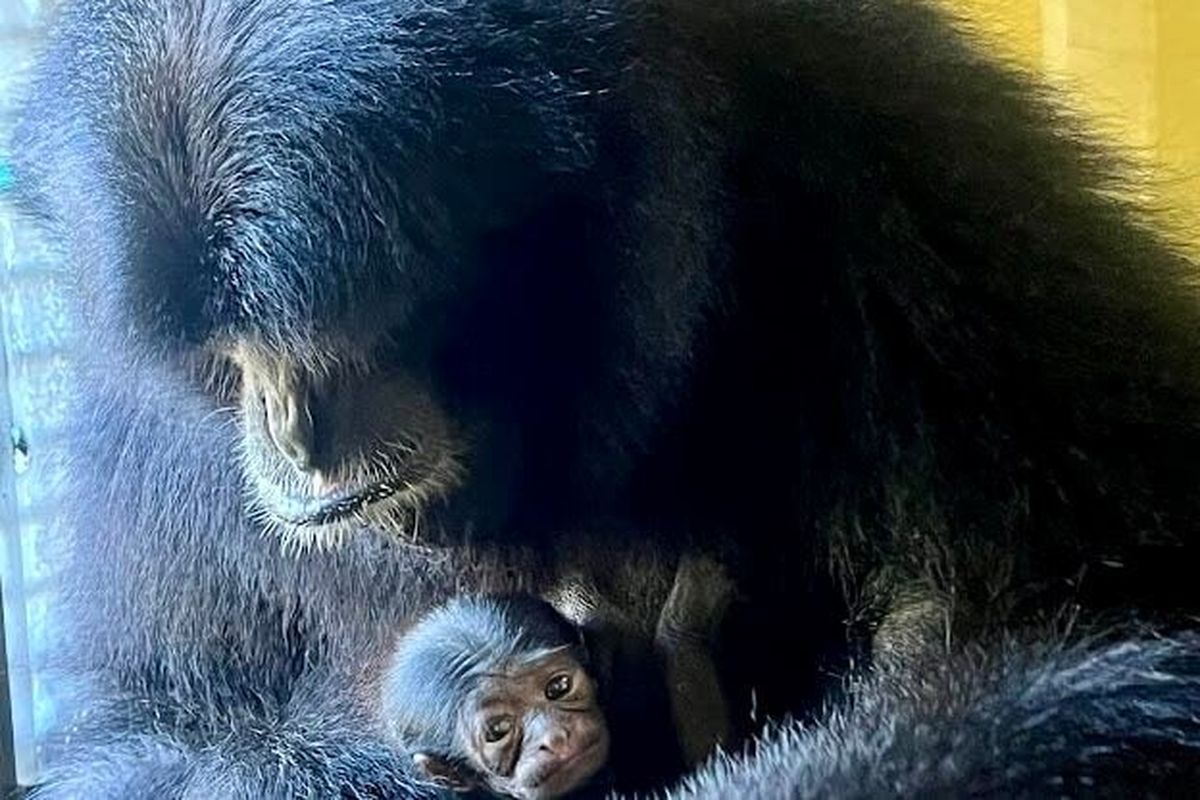Birth of an endangered ape: ‘This new baby has brought a lot of hope’

Siamang gibbons have arms that are 1½ times the length of their legs, making it easy to swing from tree to tree.
But the endangered primates’ long forelimbs also have another purpose: hugging their moms.
A rare baby siamang born at ZooTampa in Florida last month is delighting visitors as it clings tightly to the shaggy hair on its mother’s belly.
“Like all siamangs, the baby was born with a really strong grip,” said Tiffany Burns, senior director of animal programs at the zoo.
Other than a tuft of dark hair on its head, the infant ape is mostly hairless. The baby will cling to its mom, Hutan, for three or four months, and a long and dense coat will begin growing in about two to three years.
“Immediately after the birth, [Hutan] was cleaning up the baby, signifying that she has everything in control,” Burns said. “It’s been really sweet to watch the bond form with the baby and mom.”
Zoo staffers have plenty to celebrate after the Oct. 27 birth, Burns said.
Siamang gibbons are endangered throughout Asia, mainly because of destruction of the rainforest to make room for palm oil plantations. Palm oil is the most widely consumed vegetable oil in the world and is found in everything from cookies and ice cream to shampoo and lipstick.
The population of siamangs has plummeted by 50 % over the past five decades in Malaysia, Indonesia and Thailand, and there are now fewer than 200,000 living in the wild, Burns said.
Dozens are swinging from trees and structures in 43 U.S. zoos, including the Smithsonian National Zoo, which houses a pair of siamangs.
“To see this new baby has brought a lot of hope,” Burns said. “It’s a joy to watch them as a family unit, knowing that people who see them will want to learn more about them and help to protect them.”
The zoo won’t know the sex of the new siamang for a couple of months, she said, noting that the ape has not yet been named. The baby is the second offspring of mom Hutan, 17, and dad Sensei, 15.
“Siamangs tend to be monogamous and stay with the same mate for life,” Burns said. “Since the birth, we’ve been giving them some space and letting them have their time together as a family.”
For the first year, the baby will be nursed and carried around by Hutan, then Sensei will take over the parenting duties like siamangs do in the wild. The young siamang will eventually be singing and swinging in the zoo’s outdoor play structure with 3-year-old sister Kazuki, Burns said.
Siamang gibbons mainly eat leaves and fruit and are known for their loud songs, especially in the morning, when adults call out for long periods to claim their territory.
“It’s typically done between the male and the female, and with every pair, the song will be different,” Burns said. “When they start singing at the zoo, everyone can hear them.”
Kazuki often chimes in with her parents, she said, and the big sister is closely watching her mother as she cares for their new family member.
“She’s watching her nurse the baby and is learning how to be a good mom,” she said. “When Kazuki is old enough, we’ll work to identify a good place for her at another accredited zoo, where she can be paired off to start a family of her own.”
For now, ZooTampa staff and visitors are rejoicing in watching the family’s simple routines of grooming, eating, sleeping and acrobatic swinging.
Burns said the best way to increase siamang numbers in the wild is to look closely at ingredient lists on groceries to ensure products are made from sustainable palm oil.
“People wonder how they can help when these fragmented forests are in Indonesia, and they’re slashing and burning to get the oil,” she said. “But there are sustainable farmers making a difference in Asia, and we should support them.”
Deforestation in Indonesia is declining, providing hope after decades of wildlife habitat destruction.
The siamang’s treetop song is one that everyone should hear, said Burns.
“When people see a baby siamang, maybe that will get them thinking about what they can do to help [wildlife] in their own backyard,” she said.